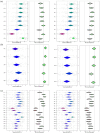Determinants of Familiarity and Experience with HIV Pre-Exposure Prophylaxis in Primary Care Providers in Ontario, Canada
- PMID: 39846350
- PMCID: PMC11755537
- DOI: 10.1177/21501319251315566
Determinants of Familiarity and Experience with HIV Pre-Exposure Prophylaxis in Primary Care Providers in Ontario, Canada
Abstract
Background: Despite increased access to HIV pre-exposure prophylaxis (PrEP) in Canada, familiarity and experience among primary care providers (PCPs)-including family doctors and those working with key populations-remains limited. To understand the barriers and facilitators of PrEP familiarity and experience, we conducted a situational analysis in PCPs in sub-urban and rural Ontario.
Methods: We surveyed a non-probabilistic sample of PCPs using an online questionnaire, designed with the Consolidated Framework for Implementation Research (CFIR). Poisson regressions with robust variance were used to assess the relationship between CFIR domains, sociodemographic, and practice characteristics on both PrEP familiarity and experience.
Results: A total of 54 PCPs participated (6% response rate), comprising 80% physicians and 20% nurses. Nearly 30% of the sample worked with key populations, including sexual health clinics and community care centers, 18% of respondents reported high familiarity with PrEP, and 44% reported PrEP experience (referred, started a conversation, or prescribed). PrEP familiarity and experience were associated with working in an organization serving key populations, working with gender minorities, and having colleagues providing PrEP. Providers with a positive perception of PrEP and its necessity for populations at risk were more likely to have PrEP-related experience. Higher familiarity and experience were reported by PCPs with specific clinical skills related to PrEP, and with the perception that PrEP was compatible with their practice as primary provider.
Conclusions: Our findings suggest that organizational support, and additional training and education would facilitate PrEP provision by PCPs in suburban/rural Ontario.
Keywords: HIV pre-exposure prophylaxis (PrEP); HIV prevention; implementation science; primary care providers (PCPs).
Conflict of interest statement
Declaration of Conflicting InterestsThe authors declared no potential conflicts of interest with respect to the research, authorship, and/or publication of this article.
Figures




Similar articles
-
A Cross-Sectional Online Survey of HIV Pre-Exposure Prophylaxis Adoption Among Primary Care Physicians.J Gen Intern Med. 2017 Jan;32(1):62-70. doi: 10.1007/s11606-016-3903-z. Epub 2016 Oct 24. J Gen Intern Med. 2017. PMID: 27778215 Free PMC article.
-
PrEP Awareness, Familiarity, Comfort, and Prescribing Experience among US Primary Care Providers and HIV Specialists.AIDS Behav. 2017 May;21(5):1256-1267. doi: 10.1007/s10461-016-1625-1. AIDS Behav. 2017. PMID: 27885552 Free PMC article.
-
HIV-Related Training and Correlates of Knowledge, HIV Screening and Prescribing of nPEP and PrEP Among Primary Care Providers in Southeast United States, 2017.AIDS Behav. 2019 Nov;23(11):2926-2935. doi: 10.1007/s10461-019-02545-1. AIDS Behav. 2019. PMID: 31172333 Free PMC article.
-
Health Care Provider Barriers to HIV Pre-Exposure Prophylaxis in the United States: A Systematic Review.AIDS Patient Care STDS. 2020 Mar;34(3):111-123. doi: 10.1089/apc.2019.0189. Epub 2020 Feb 28. AIDS Patient Care STDS. 2020. PMID: 32109141 Free PMC article.
-
Pre-Exposure Prophylaxis: A Narrative Review of Provider Behavior and Interventions to Increase PrEP Implementation in Primary Care.J Gen Intern Med. 2017 Feb;32(2):192-198. doi: 10.1007/s11606-016-3899-4. Epub 2016 Oct 19. J Gen Intern Med. 2017. PMID: 27761767 Free PMC article. Review.
References
-
- Girometti N, Delpech V, McCormack S, et al.. The success of HIV combination prevention: the Dean Street model. HIV Med. 2021;22:892-897. - PubMed
-
- Grulich AE, Jin F, Bavinton BR, et al.. Long-term protection from HIV infection with oral HIV pre-exposure prophylaxis in gay and bisexual men: findings from the expanded and extended EPIC-NSW prospective implementation study. Lancet HIV. 2021;8:e486-e494. - PubMed
MeSH terms
Substances
LinkOut - more resources
Full Text Sources
Medical
Miscellaneous

